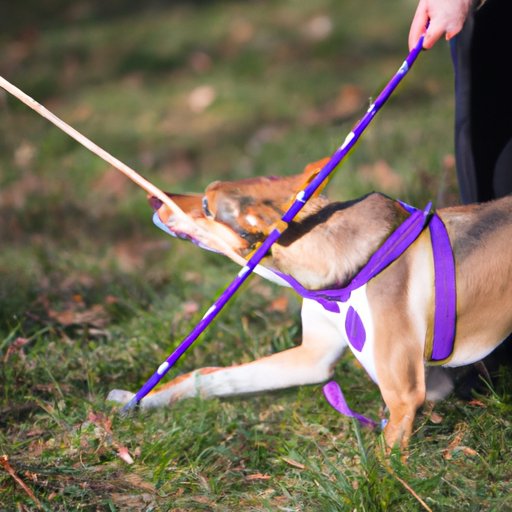Introduction
Eating sticks is a common problem for many dog owners. It can be dangerous for your pooch, as it can cause choking or intestinal blockage. However, there are several steps you can take to help your pup stop this dangerous habit. In this article, we’ll explore some strategies that can help you stop your dog from eating sticks.
Definition of the Problem
Dogs may eat sticks for a variety of reasons. According to veterinarian Dr. Sarah Nold, “Some dogs eat sticks because they’re bored or looking for something to do. Others may do it out of curiosity or even as a way to get attention.” Additionally, many dogs like the taste of wood, so they may be drawn to sticks for that reason.

Training Your Dog to Respond to Verbal Commands
One of the best ways to keep your pup from eating sticks is to train them to respond to verbal commands. This will allow you to instruct your pet to “leave it” or “drop it” when they try to pick up a stick. Here are some tips to help you train your pup to respond to verbal commands.
Establishing a Reward System
The most effective way to teach your pup to obey commands is by establishing a reward system. Whenever your pup responds correctly to a command, reward them with a treat or verbal praise. This will reinforce the desired behavior and make it more likely that your pup will obey your commands in the future.
Teaching Basic Commands
Once you have established a reward system, you can start teaching your pup basic commands such as “leave it” or “drop it”. Start by getting your pup’s attention, then give the command. If your pup responds correctly, reward them with a treat or verbal praise. Repeat this process until your pup consistently obeys the command. This technique can be used to discourage your pup from picking up sticks as well.
Keeping Your Dog on a Leash
Keeping your pup on a leash is another effective way to prevent them from eating sticks. This will limit their ability to wander off and find sticks to eat. Here are some tips to help you keep your pup on a leash.
Benefits of Having Your Dog on a Leash
Having your pup on a leash provides several benefits. It allows you to control your pup’s movements and keep them away from potentially dangerous items such as sticks. Additionally, it can help you avoid confrontation with other animals or people.
Practical Tips for Keeping Your Dog on a Leash
When keeping your pup on a leash, it’s important to use a leash that is comfortable for both you and your pup. Make sure the leash is not too tight, as this can cause discomfort. Additionally, it’s important to keep the leash loose enough to allow your pup to explore, but not so loose that they can wander off and find sticks to eat.

Distracting Your Dog with Toys and Treats
Distracting your pup with toys and treats is another effective way to keep them from eating sticks. Here are some tips to help you use distractions to discourage this behavior.
Types of Toys and Treats That Can Be Used as Distractions
There are many types of toys and treats that can be used as distractions. For example, chew toys, kongs, and puzzle toys can be used to keep your pup occupied. Additionally, treats such as jerky, cheese, and peanut butter can be used to entice your pup away from sticks.
How to Use These Distractions Effectively
To effectively use distractions to discourage your pup from eating sticks, it’s important to offer them an alternative activity. Whenever your pup tries to pick up a stick, distract them with a toy or treat. This will help them associate the act of picking up sticks with something negative, such as the lack of a reward.
Discouraging the Behavior
In addition to using toys and treats as distractions, it’s important to actively discourage your pup from eating sticks. Some methods that can be used include clapping loudly or making a stern noise whenever they try to pick up a stick. Additionally, offering alternative activities that do not involve picking up sticks can help discourage this behavior.

Creating a Safe Enclosed Area
Creating a safe enclosed area is another effective way to keep your pup from eating sticks. Here are some tips to help you create an enclosed area for your pup.
Benefits of Creating a Safe Enclosed Area
Creating a safe enclosed area has several benefits. It can help keep your pup away from potentially dangerous items such as sticks. Additionally, it can help contain messes and provide a secure environment for your pup to play in.
Steps to Create an Enclosed Area
To create an enclosed area for your pup, you will need to purchase a fence or gate. Make sure the fence or gate is tall enough to keep your pup contained. Additionally, you should also purchase a locking mechanism to ensure your pup cannot escape. Once the area is set up, you can use toys and treats to encourage your pup to stay inside the enclosure.
Conclusion
Eating sticks can be a dangerous habit for dogs. Fortunately, there are several steps you can take to help your pup stop this behavior. Training your pup to respond to verbal commands, keeping them on a leash, distracting them with toys and treats, and discouraging the behavior can all help keep your pup away from sticks. Additionally, creating a safe enclosed area can provide an additional layer of protection. By following these tips, you can help keep your pup safe and discourage them from eating sticks.
(Note: Is this article not meeting your expectations? Do you have knowledge or insights to share? Unlock new opportunities and expand your reach by joining our authors team. Click Registration to join us and share your expertise with our readers.)
